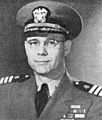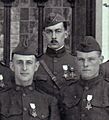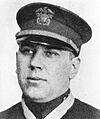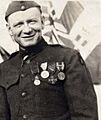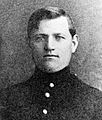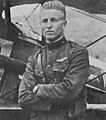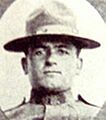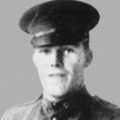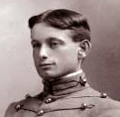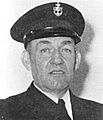List of Medal of Honor recipients for World War I facts for kids
World War I (also known as the First World War or the Great War) was a huge global conflict. Most of the world's powerful countries were involved. They were split into two main groups: the Allies and the Central Powers. The war started on June 28, 1914. This was after Archduke Franz Ferdinand, who was going to be the next ruler of Austria-Hungary, was assassinated. A young man named Gavrilo Princip killed him. This event caused a chain reaction. Countries started declaring war on each other. Soon, much of Europe was fighting. Over 65 million European soldiers joined the fight. More than 40 million people were hurt or died. About 20 million people died by the end of the war.
When World War I began, the United States tried to stay out of the fighting. This was called a policy of isolationism. The U.S. wanted to help make peace between the countries. But in 1915, a German U-boat (submarine) sank a British ship called the Lusitania. There were 128 Americans on board who died. U.S. President Woodrow Wilson demanded that Germany stop attacking passenger ships. Germany agreed for a while. President Wilson tried to help settle the war, but he was not successful. He kept warning Germany that the U.S. would not allow them to attack ships without warning. This was against international rules.
The United States joined the war in 1917. This was three years after the war started. Even before the U.S. officially joined, some Americans went to fight. They became pilots by joining the Royal Flying Corps. These pilots went to Canada for training. Then, they fought as officers for the British military.
The Medal of Honor
The Medal of Honor is a very special award. It was first created during the American Civil War. It is the highest military award given by the United States government. A soldier, sailor, or Marine can receive it. To get this medal, a person must show extreme bravery. They must risk their own life in a way that is far beyond what is expected. This must happen while fighting an enemy of the United States. Because of how special it is, the medal is often given after a person has died. This is called posthumously.
About 125 men received the Medal of Honor for their actions in World War I. Thirty-four of these medals were given after the person had died. Ninety-two medals went to the Army. This included four from the Air Service. Twenty-one went to the Navy. Ten of these were for actions not directly in combat. Eight medals went to the Marine Corps.
Some famous recipients included Alvin York. His story later became a movie called Sergeant York. Another was Edward Rickenbacker, who became a very skilled pilot known as a flying ace. Ralph Talbot was also a flying ace from the Marine Corps. He was the first Marine pilot to receive the Medal of Honor.
Since the Medal of Honor was created, 19 people have received it twice. Five of these people received both awards during World War I. All five were Marines. They received both the Army and Navy versions of the medal for the same brave action. This was possible because some Marine Corps units worked with larger U.S. Army groups. The Marine Corps is part of the Department of the Navy. This meant Marines in these units could get awards from both the Army and the Navy. In February 1919, the rules changed. It was decided that no one could receive more than one Medal of Honor. This stopped any future double awards.
Brave Actions in World War I
Many brave Americans earned the Medal of Honor during World War I. Here are some examples of their amazing courage:
- Joseph B. Adkison (Army Sergeant): He bravely attacked and captured a machine gun position all by himself.
- Jake Allex (Army Corporal): After all his officers were hurt, he took charge of his group. He then captured a machine gun nest alone.
- Edward C. Allworth (Army Captain): He swam across a canal while being shot at. He encouraged his men to follow him. Then, he led them to capture 100 enemy soldiers.
- Johannes S. Anderson (Army First Sergeant): He attacked and captured a machine gun nest by himself.
- Albert E. Baesel (Army Second Lieutenant): He was killed while trying to save a wounded soldier. This happened under heavy enemy fire.
- John H. Balch (Navy Pharmacist's Mate First Class): He risked his life to treat wounded soldiers. He also set up a medical station while under intense fire.
- Charles D. Barger (Army Private First Class): With Jesse N. Funk, he went into the dangerous "no man's land." They rescued two wounded officers.
- David B. Barkley (Army Private): He swam across the Meuse River to scout German positions. He was under heavy fire. He drowned on his way back.
- John L. Barkley (Army Private First Class): He used a machine gun inside a broken tank. He stopped two German attacks all by himself.
- Frank J. Bart (Army Private): He attacked and silenced two machine gun nests alone.
- Robert L. Blackwell (Army Private): He was killed trying to deliver a message for help. This was through heavy enemy fire.
- Erwin R. Bleckley (Army Air Service Second Lieutenant): He was killed trying to deliver supplies by air to the Lost Battalion. This was with Harold Goettler.
- Joel T. Boone (Navy Lieutenant): He risked his life to treat wounded soldiers and bring in supplies under heavy fire.
- Willis W. Bradley, Jr. (Navy Lieutenant): He went into a room full of explosives. He put out a fire after an accidental blast.
- Deming Bronson (Army First Lieutenant): He kept fighting even though he was badly wounded.
- Donald M. Call (Army Corporal): He saved a wounded officer from a broken tank. He carried him to safety under intense fire.
- Tedford H. Cann (Navy Seaman): He dove into a flooded part of his ship. He found and plugged a leak that threatened to sink the ship.
- Marcellus H. Chiles (Army Captain): He led his men from the front. He kept going despite heavy machine gun fire until he was fatally wounded.
- Wilbur E. Colyer (Army Sergeant): He attacked and silenced three machine gun nests by himself.
- Henry G. Costin (Army Private): He was fatally wounded while attacking a machine gun nest alone. Everyone else in his team was already hurt.
- Jesse W. Covington (Navy Ship's Cook Third Class): He jumped overboard and saved a man. The man was surrounded by exploding boxes.
- Louis Cukela (Marine Corps Sergeant): He attacked and captured a strong German position all by himself.
- George Dilboy (Army Private First Class): He was fatally wounded while attacking and silencing a machine gun position alone.
- Michael A. Donaldson (Army Sergeant): He rescued six wounded men despite intense enemy fire.
- William J. Donovan (Army Lieutenant Colonel): He risked his life to lead and organize his men. He stayed with them even after being wounded. He is the only person to receive the four highest U.S. awards.
- James C. Dozier (Army First Lieutenant): He kept leading after being wounded. With another soldier, he silenced a machine gun nest.
- Parker F. Dunn (Army Private First Class): He was killed while carrying a message through heavy enemy fire.
- Daniel R. Edwards (Army Private First Class): Even though he was badly hurt, he went into a German trench alone. He killed or captured the enemy soldiers there.
- Alan L. Eggers (Army Sergeant): With J.C. Latham and Thomas E. O'Shea, he saved the crew of a broken tank. They protected them from attack all day.
- Michael B. Ellis (Army Sergeant): He attacked and captured several German positions by himself.
- Arthur J. Forrest (Army Sergeant): He attacked and silenced a machine gun nest alone.
- Gary E. Foster (Army Sergeant): He silenced a machine gun nest by himself.
- Jesse N. Funk (Army Private First Class): With Charles D. Barger, he went into "no man's land." They rescued two wounded officers.
- Harold A. Furlong (Army First Lieutenant): He attacked and silenced a series of machine gun nests alone.
- Frank J. Gaffney (Army Private First Class): He captured and held a German position by himself until help arrived.
- Harold E. Goettler (Army Air Service First Lieutenant): He was killed trying to deliver supplies by air to the Lost Battalion. This was with Erwin Bleckley.
- Ora Graves (Navy Seaman): He put out a fire after an accidental explosion.
- Earle D. Gregory (Army Sergeant): He attacked and captured three German positions by himself.
- Sydney G. Gumpertz (Army First Sergeant): He silenced a machine gun nest alone.
- Thomas L. Hall (Army Sergeant): He attacked and silenced a machine gun nest by himself. He was killed while attacking a second one.
- Charles H. Hammann (Naval Reserve Ensign): He rescued a fellow pilot whose plane had been shot down.
- M. Waldo Hatler (Army Sergeant): He swam across the Meuse River to scout German positions. He was under heavy fire.
- David E. Hayden (Navy Hospital Apprentice First Class): He reached a wounded man, treated him, and carried him to safety despite intense fire.
- George P. Hays (Army First Lieutenant): He carried messages through heavy enemy fire.
- James D. Heriot (Army Corporal): He attacked and captured a machine gun nest alone. He was killed while attacking a second one.
- Ralyn M. Hill (Army Corporal): He ran through heavy fire to rescue a French pilot whose plane had crashed.
- Richmond H. Hilton (Army Sergeant): He led an attack that successfully captured a machine gun nest.
- Nelson M. Holderman (Army Captain): As part of the Lost Battalion, he kept leading even after being wounded many times. He also rescued two wounded men under intense fire.
- Osmond K. Ingram (Navy Gunner's Mate First Class): He was killed trying to release depth charges as a torpedo approached his ship.
- Edouard V. M. Izac (Navy Lieutenant): He gathered important information while he was a prisoner of war. He then escaped and brought the information to the Allies.
- Ernest A. Janson (Marine Corps Gunnery Sergeant): He attacked and scattered a machine gun group by himself.
- Harold I. Johnston (Army Private First Class): He swam across the Meuse River to scout German positions. He was under heavy fire.
- Henry Johnson (Army Sergeant): He fought off a group of 24 German raiders. He suffered 21 wounds. He received his medal posthumously in 2015.
- James E. Karnes (Army Sergeant): With Calvin Ward, he attacked and captured a machine gun nest.
- Phillip C. Katz (Army Sergeant): He rescued a wounded man from under heavy fire.
- Benjamin Kaufman (Army First Sergeant): Even though he was wounded, he attacked and captured a machine gun by himself.
- John J. Kelly (Marine Corps Private): He attacked a machine gun nest alone during an artillery attack.
- Matej Kocak (Marine Corps Sergeant): He silenced a machine gun nest by himself. He then led a successful attack on another nest.
- John C. Latham (Army Sergeant): With Alan L. Eggers and Thomas E. O'Shea, he saved the crew of a broken tank. They protected them from attack all day.
- Milo Lemert (Army First Sergeant): He silenced three machine guns by himself. He was killed while attacking a fourth with another man.
- Berger Loman (Army Private): He attacked and captured a machine gun by himself.
- Frank Luke, Jr. (Army Air Service Second Lieutenant): He destroyed three enemy observation balloons. He was then forced to land because he was fatally wounded.
- Alexander G. Lyle (Navy Lieutenant Commander): He risked his life to treat a wounded man under enemy fire.
- John MacKenzie (Navy Chief Boatswain's Mate): He secured a live depth charge (an explosive) that was dangerous.
- James J. Madison (Naval Reserve Lieutenant Commander): He kept leading his ship even after being badly wounded during a submarine attack.
- George H. Mallon (Army Captain): He led a small group to capture several German positions.
- Sidney E. Manning (Army Corporal): He took command of his group. Even though he was wounded many times, he led his men forward.
- Patrick McGunigal (Navy Shipfitter First Class): He rescued the pilot of a crashed observation balloon.
- George G. McMurtry (Army Captain): As part of the Lost Battalion, he kept leading and encouraging his men. This was even after being wounded many times.
- James I. Mestrovitch (Army Sergeant): He rescued a wounded officer from under heavy fire.
- L. Wardlaw Miles (Army Captain): He led an attack against a German trench. He kept leading after being severely wounded.
- Oscar F. Miller (Army Major): He kept leading an attack even after being wounded many times. He later died from his wounds.
- Sterling L. Morelock (Army Private): He led a small group to capture several machine gun nests. Then, he treated the wounded.
- Thomas C. Neibaur (Army Private): Even though he was wounded and separated from his group, he helped hold off a German counterattack.
- Richard W. O'Neill (Army Sergeant): He kept leading an attack even after being wounded many times.
- Francis E. Ormsbee, Jr. (Navy Chief Machinist's Mate): He rescued the gunner of a downed plane. He tried to rescue the pilot but was not successful.
- Weedon E. Osborne (Navy Lieutenant, Junior Grade): He was killed while rescuing wounded men under heavy fire.
- Thomas E. O'Shea (Army Corporal): He was killed while trying to rescue the crew of a broken tank. This was with J.C. Latham and Alan L. Eggers.
- Samuel I. Parker (Army Second Lieutenant): He led an attack that captured a German strong point. He kept leading after being wounded.
- Archie A. Peck (Army Private): He rescued two wounded men from under heavy fire.
- Michael J. Perkins (Army Private First Class): He attacked and captured a German pillbox (a small concrete fort) by himself.
- Orlando H. Petty (Naval Reserve Lieutenant): He cared for the wounded despite artillery and gas attacks. This was even after his gas mask stopped working.
- Emory Jenison Pike (Army Lieutenant Colonel): He kept leading after being fatally wounded while helping an injured soldier.
- Thomas A. Pope (Army Corporal): He attacked and silenced a machine gun nest by himself.
- John H. Pruitt (Marine Corps Corporal): He captured two machine guns and forty prisoners by himself.
- Patrick Regan (Army Second Lieutenant): He led his group to capture a machine gun nest. He kept leading after being wounded.
- Edward V. Rickenbacker (Army Air Service First Lieutenant): He attacked seven German planes and shot down two of them.
- George S. Robb (Army First Lieutenant): He kept leading even after being wounded many times.
- Harold W. Roberts (Army Corporal): He drowned after pushing another man to safety. Their tank had fallen into a shell hole filled with water.
- Robert G. Robinson (Marine Corps Gunnery Sergeant): He kept firing his weapon even after being badly wounded in a plane fight against twelve German planes.
- Samuel M. Sampler (Army Corporal): He attacked and silenced a machine gun nest by himself.
- Willie Sandlin (Army Sergeant): He attacked three machine gun nests by himself.
- William Sawelson (Army Sergeant): He was killed while helping a wounded man under heavy fire.
- Dwite H. Schaffner (Army First Lieutenant): He led his men in defending against German attacks. He personally captured a German officer and got information from him.
- Oscar Schmidt, Jr. (Navy Chief Gunner's Mate): He rescued a wounded man from the water and tried to rescue another.
- Lloyd M. Seibert (Army Sergeant): Even though he was sick, he led his men in an attack on a machine gun. He kept leading after being wounded.
- William Shemin (Army Sergeant): He rescued wounded soldiers under heavy fire. He took command of his group after his leaders were hurt. He received his medal posthumously in 2015.
- John O. Siegel (Navy Boatswain's Mate Second Class): He rescued two men from a burning ship. He then got trapped and passed out from the smoke.
- Alexander R. Skinker (Army Captain): He was killed while leading two other men in an attack on German pillboxes.
- Clayton K. Slack (Army Private): He attacked and captured a group of German soldiers by himself.
- Fred E. Smith (Army Lieutenant Colonel): He drew German fire onto himself so his men could find cover. He got grenades and was fatally wounded while planning a counterattack.
- Fred W. Stockham (Marine Corps Gunnery Sergeant): He gave his gas mask to a wounded friend. He later died from breathing in poison gas.
- Freddie Stowers (Army Corporal): He led an attack on German positions. He kept leading even after being fatally wounded.
- Daniel A. J. Sullivan (Naval Reserve Ensign): He secured a group of live depth charges (explosives).
- Ralph Talbot (Marine Corps Second Lieutenant): With his gunner Robert G. Robinson, he shot down one plane in an air battle against twelve German aircraft.
- Edward R. Talley (Army Sergeant): He attacked and silenced a machine gun by himself.
- Joseph H. Thompson (Army Major): He walked towards a German machine gun nest, guiding a tank, despite intense fire.
- Harold L. Turner (Army Corporal): He attacked and captured a German strong point by himself.
- William B. Turner (Army First Lieutenant): He was killed while leading his men in a series of attacks, even though he was wounded.
- Frank M. Upton (Navy Ensign): He jumped overboard and rescued a man. The man was surrounded by exploding boxes.
- Michael Valente (Army Private): With another man, he silenced two machine gun nests and attacked a German trench.
- Ludovicus M. M. Van Iersel (Army Sergeant): Under heavy fire, he scouted a damaged bridge. He then swam the river to check on German positions.
- John C. Villepigue (Army Corporal): He attacked a dugout (an underground shelter) and captured a machine gun nest by himself.
- Reidar Waaler (Army Sergeant): He rescued two men from a burning tank under heavy fire.
- Calvin J. Ward (Army Private): With James Karnes, he attacked and captured a machine gun nest.
- Chester H. West (Army First Sergeant): He attacked a machine gun nest by himself.
- Charles W. Whittlesey (Army Major): As the commander of the Lost Battalion, he led his group to hold their position and refused to give up.
- J. Hunter Wickersham (Army Second Lieutenant): He kept leading and fighting after being fatally wounded.
- Nels Wold (Army Private): With another soldier, he silenced four machine gun nests. He was killed while attacking a fifth.
- Samuel Woodfill (Army First Lieutenant): With help from his company, he attacked and silenced three machine gun nests.
- Alvin C. York (Army Corporal): He took command of his group and led an attack on a machine gun nest.
Images for kids
See also






